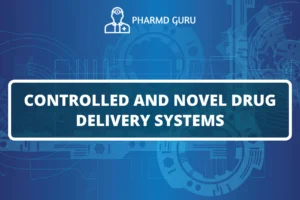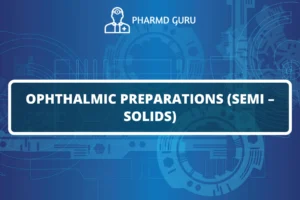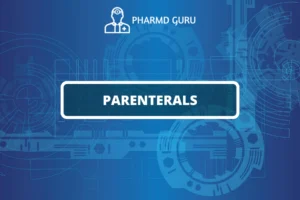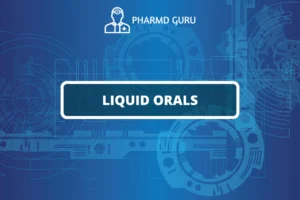Tablets are one of the most commonly used pharmaceutical dosage forms. They offer convenience, accurate dosing, and stability, making them a preferred choice for oral drug delivery. In this article, we will explore various aspects related to tablets, including their formulation, excipients, granulation techniques, coating, and quality control measures.
SCROLL DOWN TO THE BOTTOM OF THIS PAGE FOR ACTUAL NOTES.
Table of Contents
- Introduction
- Formulation of Tablets
- 2.1 Active Pharmaceutical Ingredient (API)
- 2.2 Excipients
- Granulation Techniques for Tablet Production
- Tablet Coating
- 4.1 Types of Tablet Coating
- 4.2 Quality Control Tests for Coated Tablets
- Quality Control and Evaluation of Tablets
1. Introduction
Tablets are solid dosage forms that contain medicinal substances in a compressed form. They consist of one or more active pharmaceutical ingredients (APIs) along with various excipients. Tablets offer advantages such as accurate dosing, ease of administration, and enhanced stability, making them widely used in the pharmaceutical industry.
2. Formulation of Tablets
The formulation of tablets involves the selection and combination of appropriate ingredients to achieve the desired therapeutic effect. The two main components of tablet formulation are the active pharmaceutical ingredient (API) and excipients.
2.1 Active Pharmaceutical Ingredient (API)
The API is the primary therapeutic component of a tablet. It is responsible for the intended pharmacological effect. The selection of the API depends on the desired therapeutic outcome and the condition being treated.
2.2 Excipients
Excipients are inactive substances that are added to the tablet formulation to facilitate the manufacturing process and enhance the properties of the final product. Excipients may include binders, disintegrants, lubricants, glidants, fillers, and coloring agents. Each excipient serves a specific purpose, such as ensuring tablet cohesion, promoting disintegration, improving flow properties, or enhancing appearance.
3. Granulation Techniques for Tablet Production
Granulation is a process used in tablet manufacturing to improve the flow properties and compressibility of the formulation. There are several granulation techniques, including wet granulation, dry granulation, and direct compression.
- Wet Granulation: In this technique, the API and excipients are mixed with a liquid binder to form granules. The wet mass is then dried and sieved before compression.
- Dry Granulation: Dry granulation involves the compaction of the API and excipients without the use of any liquid binder. The blend is compressed into slugs or ribbons, which are then milled and sieved before final compression.
- Direct Compression: Direct compression is a simpler technique that involves the direct compression of the API and excipients without the need for granulation. It is suitable for formulations that have good flow properties and compressibility.
The choice of granulation technique depends on the specific characteristics of the formulation, such as the API properties, desired release profile, and manufacturing requirements.
4. Tablet Coating
Tablet coating is a process that involves the application of a coating layer on the surface of tablets. Coating provides several benefits, including improved appearance, taste masking, protection of the API from moisture and light, and controlled release of the drug. The coating also facilitates swallowing and enhances patient compliance.
4.1 Types of Tablet Coating
There are different types of tablet coatings, including:
- Sugar Coating: Sugar coating is the traditional method of tablet coating. It involves the successive application of multiple layers of sugar-based solutions to create a smooth, glossy, and protective coating.
- Film Coating: Film coating is a modern technique that involves the application of a thin polymer film on the tablet surface. It provides a uniform and more durable coating compared to sugar coating.
- Enteric Coating: Enteric coating is used when it is necessary to protect the tablet from the acidic environment of the stomach and ensure drug release in the intestinal region.
4.2 Quality Control Tests for Coated Tablets
Coated tablets undergo various quality control tests to ensure their integrity and performance. Some common quality control tests for coated tablets include:
- Visual Inspection: Tablets are visually inspected for defects such as cracks, chips, discoloration, and uneven coating.
- Disintegration Test: The disintegration test assesses the time it takes for the coating to dissolve and the tablet to disintegrate in a specific medium.
- Dissolution Test: The dissolution test evaluates the release rate of the active ingredient from the coated tablet using appropriate dissolution apparatus and media.
- Thickness and Weight Variation: Coated tablets are measured for their thickness and checked for weight uniformity to ensure consistent dosing.
5. Quality Control and Evaluation of Tablets
Tablets undergo rigorous quality control measures to ensure their safety, efficacy, and compliance with regulatory standards. Quality control tests for tablets include:
- Identification and Assay of Active Ingredient: The active ingredient is identified and quantified using appropriate analytical methods.
- Content Uniformity: Content uniformity testing ensures that the amount of active ingredient in each tablet is within the specified range.
- Hardness and Friability: Tablets are tested for hardness to assess their mechanical strength, and friability testing evaluates the tablet’s resistance to abrasion during handling.
- Disintegration Time: Disintegration testing determines the time it takes for the tablet to break down into smaller particles in a specific medium.
- Stability Testing: Tablets undergo stability testing to assess their physical, chemical, and microbiological stability over time under different storage conditions.
ACTUAL NOTES:




